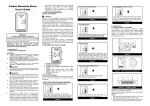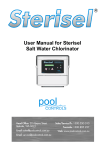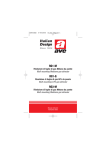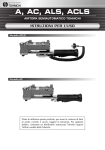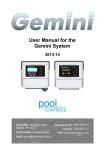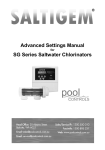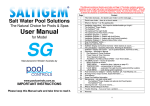Download GAS&CO-CO-User Manual V1.0
Transcript
GAS ATTENTION: Please take a few minutes to thoroughly read this manual, which should be saved for future reference and passed on to any subsequent owner. (The default setting is LNG, select by JP3 on PCB board.) CO Gas:50ppm-150ppm (Alarm in Less than 15 minutes) >150ppm (Alarm in Less than 2 minutes) Alarm: Red LED with 80dB alarm Warm Up Time: approximately 45 Seconds Alarm Output: Relay Output (2A@DC24V, 1A@220VAC) (Only for relay output Module) Wireless Output: 315MHz or 433MHz, 150m open space (Only Wireless Module) Accessories: Plastic mounting bracket Mounting screws with anchors 4. THE COVER AND OF YOUR ALARM 67mm FIGURE 1 UNIT & INSTALLATION BRACKET 6. TERMINAL WIRING OF DETECTOR 1. The AC90~AC270 power supply module has a wire with plug. Not need to using terminal for power supply. 2. The DC9V~DC28V power supply module use terminal 1 and terminal 2 as power input (Unpolarized wire input). 3. Relay output module has NO/NC output. The default setting is NO. The relay output setting NO or NC can be selected by jump JP2 on the PCB board. See Figure 2. 4. Voltage output has continuous or pulse voltage output, the default setting is pulse voltage output. The voltage output setting can be selected by jump JP1. DCF option is pulse voltage output, JXS is continuous voltage output. 5. Voltage output module relay output is capable for load of 1A@220AC, if the current is exceed the limitation, one intermediate relay should be used. Terminals Description IMPORTANT! READ ALL INSTRUCTIONS BEFORE INSTALLATION AND KEEP THIS MANUAL NEAR THE DETECTOR FOR FUTURE REFERENCE. 1. DESCRIPTION The gas detector is designed for single station use or for connecting to fire alarm or security alarm panel. Small and compact, the design and color makes it ideal for use in the home, small commercial properties, and recreational vehicles. It is intended to detect leakage of natural gas (methane gas), town gas, and bottled gas (propane gas), coal gas and carbon monoxide. The unit is designed for wire-in or plug-in applications. The gas detector can be mounted high (for methane gas) or low (for Bracket 5 1 POWER CO 2 3 1. 2. 3. 4. 5. 4 GAS 6 Test/Silence/Reset Button POWER Light (Green) CO ALarm Light (Red)/Fault Light (Yellow) GAS Alarm Light (Red)/Fault Light (Yellow) (Behind the Cover) Alarm Horn: 80dB audible JP2 7 2mm T1. DC+, DC power Positive T2: DC- ,DC power Negative T3: OP-, Voltage Output Negative T4: OP+, Voltage Output Positive T5: COM, Relay Output COM T6: NO/NC, Relay Output NO/NC (default is NO) Option Setting: JP1: DCF----Pulse Voltage Output JXS-----Continuous Voltage Output JP2: NO-----Relay Contacts Normal Open NC-----Relay Contacts Normal Close JP3: LPG----Liquefied petroleum Gas LNG-----Liquefied natural gas CO SENSOR GAS SENSOR 1 2 3 4 DC+ DC- OP- OP+ 5 6 NC N0 CO TRANSFORMER DCF JXS Power BUZZER 32mm 3. TECHNICAL SPECIFICATIONS Unit Dimensions: 120mm (H) x 72 mm (W) x 42 mm (D) Color: Ceiling White Operating Temperature: -10°C to +50°C Ambient Humidity: ≤95% RH Alarm Horn: 80dB Operating Voltage: AC90V~270V, or DC9-28V Power Consumption: <1.5W (Standby), <5W (Alarm) Value of Detection Threshold (Lower Explosive Limit): LNG Gas: 7500ppm (15%LEL) LPG Gas: 2000ppm (10%LEL) FUSE 5. INSTALLATION OF DETECTOR The gas detector can be mounted on the wall. First find the suitable place to fix the bracket on the wall, and then plug the detector into the bracket. Please see figure 1. JP3 2. FEATURES l Detect all sorts of combustible gases, natural gas (methane), bottled gas (propane), LPG (Liquefied petroleum Gas), LNG (Liquefied natural gas), coal gas, including town gas and carbon monoxide. l Easy to install, mounting bracket included. l Loud 85dB alarm and LED warning light. l High quality durable sensor. l Self diagnostic function by MCU intelligent software. l Excellent reliability & High stability. l Ideal for all kitchens. LPG LNG RELAY Test/ Reset alarm for test, alarm, and unit malfunction warning. 6. Air Vents 115m m Combustible Gas & Carbon Monoxide Gas Detector User’s Guide propane (LPG) gas). It is equipped with a sturdy metal mounting bracket for quick, easy, and secure installation. JP1 COM N0/NC FIGURE 2 WIRING AND OPTION 7. INSTALLATION INSTRUCTIONS The Gas detector is intended to detect leakage of natural gas, town gas and bottled gas and carbon monoxide . It is intended for installation in the home, small commercial properties, and recreational vehicles (see Figure 3). l Installation shall only be undertaken by technicians holding a certificate issued by an authorized distributor. l For detecting natural gas (lighter than air), the detector should be installed within 30 centimeters below the ceiling and 50cm above the oven and the maximum distance away from the furnace or gas appliances is 4 meters. l For detecting LPG (heavier than air), the alarm should be installed within 30 centimeters above the floor and the maximum distance away from the furnace or gas appliances is 4 meters. l The detector should not be located close to any obstacles preventing natural air circulation. It should also not be located in a draft or close to a cooker (cooking smells and other fumes can have a bad influence on gas detection). Ceiling l Fan Nature or LPG, Coal Gas ≥50cm Oven 1.5m<L<4m Liquid Gas l l ! ! 30cm Floor ! ! FIGURE 3 WHERE TO INSTALLATION If your bedroom hallway is longer than 40 feet, install a CO Alarm at BOTH ends of the hallway. In a Single-level Home: l Install at least one CO Alarm near or within each separate sleeping area. l For added protection, install an additional CO Alarm at least 20 feet (6 meters) away from the furnace or fuel burning heat source. In a Multi-level Home: l Install at least one CO Alarm near or within each separate sleeping area. l For added protection, install at least one CO Alarm on each level of the home. If you have a basement, install that CO Alarm at the top of the basement stairs. l For added protection, install an additional CO Alarm at least 20 feet (6 meters) away from the furnace or fuel burning heat source. ! ! WARNING! This unit does not work without power. Choose an outlet where it can’t be accidentally unplugged or switched off by children. Keep small children away from the unit. Teach them not to play with it or unplug it. Explain what the alarms mean. WHERE CO ALARMS SHOULD NOT BE INSTALLED DO NOT LOCATE THIS CO ALARM: l In garages, kitchens, furnace rooms, or in any extremely dusty, dirty or greasy areas. l Closer than 20 feet from a furnace or other fuel burning heat source, or fuel burning appliances like a water heater. l Within 5 feet of any cooking appliance. l In extremely humid areas. This alarm should be at least 10 feet from a bath or shower, sauna, humidifier, vaporizer, dishwasher, laundry room, utility room or other source of high humidity. l In areas where temperature is colder than 40°F (4°C) or ! ! hotter than 100°F (38°C). These areas include unconditioned crawl spaces, unfinished attics, uninsulated or poorly insulated ceilings, porches, and garages. In turbulent air, like near ceiling fans, heat vents, air conditioners, fresh air returns, or open windows. Blowing air may prevent CO from reaching the sensors. In direct sunlight. In outlets covered by curtains or other obstruction. WARNING! This CO Alarm is designed for use inside a single-family home or apartment. It is not meant to be used in common lobbies, hallways, or basements of multi-family buildings unless working CO Alarms are also installed in each family living unit. CO Alarms in common areas may not be heard from inside individual family living units. WARNING! This CO Alarm alone is not a suitable substitute for complete detection systems in places which house many people, like hotels or dormitories, unless a CO Alarm is also placed in each unit. WARNING! DO NOT use this CO Alarm in warehouses, industrial or commercial buildings, special-purpose non-residential buildings, RVs, boats, or airplanes. This CO Alarm is specifically designed for residential use, and may not provide adequate protection in non-residential applications. 8. OPERATION AND TESTING Check and test the gas detector after installation. It should be tested weekly and check after re-occupation following a holiday. l Power Up: After turn on the power, the Green Power LED is on, buzzer beep once and the Yellow LED flashes. The unit would take approximately 45 Seconds to warm up. After warm up, the Yellow LED stop flash and the buzzer beep twice. In the warm up time, the unit doesn’t response to any operation until end of the warm up period. It’s forbidden to test detector during the warm up period. l Normal: When the unit is in normal status, the Green Power LED is on, and Yellow LED is off, Power LED flashes every 3 seconds. l Fault: When the sensor is in the fault status, the sensor Yellow LED is on, the buzzer beep (0.5s ON/3s OFF). The unit will restore to normal status after the fault has been corrected. l Alarm: While detecting the gas leaking reach the alarm level, the sensor Red Alarm LED would turn on and the buzzer sound. while the unit’s will output relay contacts output(relay output module), or output signal for electric valve or electric hand. (See Figure2). l Test: In the normal status, Press the test button and the unit should sound and the all LED light, l l no signals output. To ensure the gas detector is working, you should test it weekly. Silence: In the alarm status, press Test button, the unit enter the silence status, the sound silenced and the red LED flashes quickly, about 4 minutes late, the unit exit the silence status. Press test button again to exit the silence status. Reset: In the alarm status, press the Test button down and hold above 5 seconds, the unit would restore to normal status 9. TESTING AND MAINTENANCE WEEKLY TESTING Push and hold the Test button on the cover until a loud alarm sounds. The alarm sequence should last for 5-6 seconds. If the Detector ever fails to test properly, replace it immediately. REGULAR MAINTENANCE To keep the Detector in good working order: l Test it every week using the Test button. l Vacuum the detector cover at least twice a year, using the soft brush. Test the detector again after vacuuming. 10. GAS SAFETY GUIDE l If you hear the gas alarm sound or suspect that there is a gas leakage. You should open all windows and doors to allow the gas to disperse. l Don’t switch on lighting, press door bell, exhausting fan or any kind of electrical appliance to avoid explosion. Check all the gas appliances. Extinguish any naked flames and turn off the gas control off the gas supply. l Call the Fire department immediately outside your home or premises/ apartment. l If you are on holiday, turn off appliances switches & the gas control valve. l Do not place the bed near gas pipes or gas meter. l Do not change the location of gas pipes by yourself. l In order to ensure your home safety, please employ registered installers for regular safety inspection of all gas installation & appliances. ATTENTION: Keep these things, such as paints, chemicals, alcohol away to make a false alarm. 11. Understand the Effects of Carbon Monoxide Exposure: Low Levels: Generally 50 ppm and below. Mid Levels: Generally 50 ppm to 100 ppm. High Levels: Generally 100 ppm and above if no one is experiencing symptoms. Dangerous Levels: Generally 100 ppm and above if someone is experiencing symptoms. Concentrat ion of CO in Air (ppm=part s per million) Approximate Inhalation Time and Symptoms Developed The maximum allowable concentration for continuous exposure for healthy adults in any 8-hour period, according to OSHA*. Slight headache, fatigue, dizziness, nausea 200 ppm after 2-3 hours. Frontal headaches within 1-2 hours, life 400 ppm threatening after 3 hours. Dizziness, nausea and convulsions within 800 ppm 45 minutes. Unconsciousness within 2 hours. Death within 2-3 hours. Headache, dizziness and nausea within 20 1,600 ppm minutes. Death within 1 hour. Headache, dizziness and nausea within 3,200 ppm 5-10 minutes. Death within 25-30 minutes. Headache, dizziness and nausea within 1-2 6,400 ppm minutes. Death within 10-15 minutes. 12,800 ppm Death within 1-3 minutes. * Occupational Safety and Health Administration Reminder: This chart relates to the exposure of healthy adults. Read the info above for descriptions of those who are at higher risk. 50 ppm 12. SERVICE AND WARRANTY l Install and adjust according to this guide book. l Check the detector once a week; please keep contact with the service provider immediately if you get some problems. l Do not tear down or sling the detector randomly. l Do not use chemicals to clean the detector directly, or wash with water. l The detector is designed with automatic detection, if the gas sensor or unit in error, do not disassemble the unit yourself, but get advice from professional company or service provider. The manufacturer guarantees to take the responsibility for free repair and exchange for one year from the date of purchase if there is quality problem, and only charge for capital cost beyond


